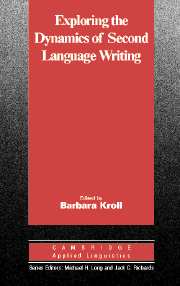Book contents
- Frontmatter
- Contents
- List of contributors
- Acknowledgments
- List of abbreviations used
- Series editors' preface
- Introduction: Teaching the next generation of second language writers
- I EXPLORING THE FIELD OF SECOND LANGUAGE WRITING
- II EXPLORING THE VOICES OF KEY STAKEHOLDERS:TEACHERS AND STUDENTS
- III EXPLORING WRITERS' FINISHED TEXTS
- Chapter 5 Responding to writing
- Chapter 6 Grammar and the ESL writing class
- Chapter 7 Writing teachers as assessors of writing
- IV EXPLORING CONTEXTUALITIES OF TEXTS
- V EXPLORING TECHNOLOGY
- EPILOGUE: EXPLORING OURSELVES
- Index
Chapter 5 - Responding to writing
Published online by Cambridge University Press: 05 October 2012
- Frontmatter
- Contents
- List of contributors
- Acknowledgments
- List of abbreviations used
- Series editors' preface
- Introduction: Teaching the next generation of second language writers
- I EXPLORING THE FIELD OF SECOND LANGUAGE WRITING
- II EXPLORING THE VOICES OF KEY STAKEHOLDERS:TEACHERS AND STUDENTS
- III EXPLORING WRITERS' FINISHED TEXTS
- Chapter 5 Responding to writing
- Chapter 6 Grammar and the ESL writing class
- Chapter 7 Writing teachers as assessors of writing
- IV EXPLORING CONTEXTUALITIES OF TEXTS
- V EXPLORING TECHNOLOGY
- EPILOGUE: EXPLORING OURSELVES
- Index
Summary
Response to student writing and its effects on writers is a vitally important topic for second language (L2) writing teachers and researchers. For many teachers, the act of responding (whether orally or in writing) represents the largest investment of time they make as writing instructors. For students, the feedback they receive from both instructors and peers may be the most significant component in their successful development as writers. The potential value of teacher feedback has been highlighted by the widespread adoption over the past fifteen years of a process approach in North American English as a second language (ESL) writing classrooms (see Matsuda, Chapter 1 this volume), meaning that students have the opportunity to receive and review teacher feedback and then to submit revised versions of their papers. Further, the increased emphasis on other forms of response in both native language (L1) and second language (L2) composition teaching, such as teacher-student conferences and peer feedback, may also be attributed to the popularity of the process approach with its cycles of multiple drafts.
The nature and effects of teacher commentary and peer feedback in L2 writing classes have both been widely investigated over the past decade. This chapter looks first at historical perspectives on response to student writing and then moves to a discussion of key issues (and their pedagogical implications) in teacher and peer response to L2 writing that have been identified by previous research. Finally, it highlights questions and strategies for future studies on this vitally important area of L2 composition research.
- Type
- Chapter
- Information
- Exploring the Dynamics of Second Language Writing , pp. 119 - 140Publisher: Cambridge University PressPrint publication year: 2003
- 18
- Cited by

